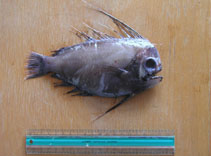| Family: |
Caristiidae (Manefishes) |
| Max. size: |
14 cm SL (male/unsexed) |
| Environment: |
bathypelagic; marine; depth range - 849 m |
| Distribution: |
Eastern Atlantic: Madeira to the coastal zone of Morocco, and off Faroe Is. |
| Diagnosis: |
Dorsal soft rays (total): 28-28; Anal soft rays: 17-17; Vertebrae: 33-34. This species is distinguished by the following characters: teeth on jaws not numerous, small, bristle-shaped, and weak (mobile) and these are located in the anterior parts of the jaws in 2 rows, in the posterior parts, in single rows; vomerine teeth bristle-shaped and numerous (approximately 20); palatine teeth bristle-shaped in 2 rows; gill rakers on the first branchial arch short, flattened, fleshy, with weakly developed spinules, total number 16; oral-branchial cavity dark; pelvic fins attached at a level of the vertical through the posterior margin of the pectoral plate and the distinct oval hollow is behind the pelvic fins anteriorly from the abdominal dermal fissure; dorsal fin with 27 rays, its origin at the vertical through the posterior margin of the orbit; head small (ca. 4 times in SL); orbit diameter less than the caudal peduncle depth (Ref. 93123). |
| Biology: |
|
| IUCN Red List Status: |
Data deficient (DD); Date assessed: 22 July 2014 Ref. (130435)
|
| Threat to humans: |
harmless |
| Country info: |
|
Source and more info: www.fishbase.org. For personal, classroom, and other internal use only. Not for publication.

